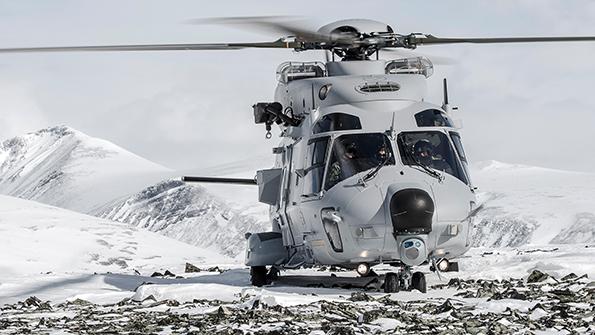
Like its Norwegian neighbors, Sweden has struggled with the NH90’s availability and cost of operation. New military advice calls for the armed forces to part with the platform in the next decade.
Availability issues are driving yet another operator of the NH90 helicopter to consider retiring it much earlier than planned.
Recommendations drawn up by Swedish Supreme Commander Gen. Micael Byden for the future development of the armed forces propose removing the European rotorcraft from the inventory by the end of 2035 at the latest. The plan calls for rationalizing the fleet around the U.S.-built Sikorsky Black Hawk and a yet-to-be-selected maritime helicopter dedicated to anti-submarine warfare (ASW), most likely Sikorsky’s MH-60 Seahawk.
- Sweden is unique in operating a high-cabin variant of the NH90.
- Its air force is frustrated by the lack of availability of the ASW version
The recommendations, published on Nov. 1, come as a new government takes office in Stockholm and the country’s armed forces prepare to join the NATO alliance. Although the proposals are just that for now, they will no doubt make miserable reading for the NH90 manufacturer, NHIndustries, a joint venture of Airbus, Leonardo and Fokker. In the past 12 months alone, the company has already seen Australia decide to retire its MRH90 Taipan early—favoring instead, like Sweden, the U.S. Black Hawk—and neighboring Norway announced it would return its 13-aircraft fleet to the OEM and demand a refund.
Even Belgium, one of the smallest NH90 operators, has scaled back operations with its battlefield utility NH90s.
Availability of the aircraft and its cost of operation were critical factors in Australia’s and Norway’s decision-making—as was the slow pace of the retrofit process to modify it from an initial operational capability for training to full operational capability.
Similar issues have influenced Sweden’s thinking. Swedish media have reported that per-hour operating costs of the NH90s exceed those of the Swedish Air Force’s Gripen combat aircraft. In July, then-Air Force Chief Maj. Gen. Carl-Johan Edstrom told journalists on the eve of the Farnborough Airshow that the NH90s were “not delivering” in their ASW mission. “The aim is to meet operational requirements earlier and increase availability within the helicopter systems to be able to support the needs of the army, special forces and navy,” the recommendations state.
NHIndustries acknowledged the proposals and responded that Sweden’s NH90s had “achieved availability rates above the average of similar helicopter types, particularly for the naval version.” The company added that Sweden’s fleet had been impacted by the retrofit and upgrade program but that this was due to be completed by the end of 2023, and the return of all the aircraft would boost availability.
NHIndustries has, its officials say, proposed “additional measures” that could “significantly improve availability and lower operating costs.” The OEM will continue to work in close cooperation with the Swedish Armed Forces to support the fleet “at a time when they are critically needed,” a reference to the new security situation prompted by the Russian invasion of Ukraine.
Sweden—which designates its 18 NH90s as Helikopter 14s—is unique in that it operates the high-cabin version of the aircraft, with increased cabin volume to provide more headroom for its personnel. But the helicopter had an inauspicious start to its Swedish career: Plans to deploy the rotorcraft for medical evacuation missions in Afghanistan were affected by delivery delays, so Sweden speedily purchased UH-60M Black Hawks from the U.S. The Black Hawks were rapidly delivered and deployed to Afghanistan.
There were also delays with the ASW aircraft, which feature a specially designed mission system developed by Saab for submarine hunting in the challenging shallow and brackish waters of the Baltic Sea. The system’s integration was complicated by the changes associated with the high-cabin version of the NH90, and their introduction to frontline service was delayed by about five years.
The proposals follow a Swedish review of its full helicopter fleet, and the NH90 will not be the only victim. The plans also call for the retirement of the Leonardo AW109 utility helicopter fleet. By 2035, the number of helicopters operated by the Swedish Armed Forces will drop from 53 operating today, according to the Aviation Week Intelligence Network’s Military Fleet Discovery database, to 36, including 27 battlefield rotorcraft and nine platforms for ASW. In addition to making changes to the helicopter fleet, Sweden is planning to purchase an advanced jet trainer in the 2030s and develop a national capacity for a responsive satellite launch as part of an investment in the space domain.





